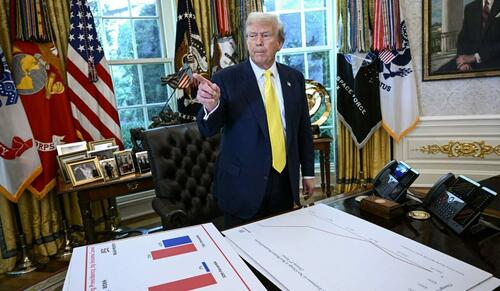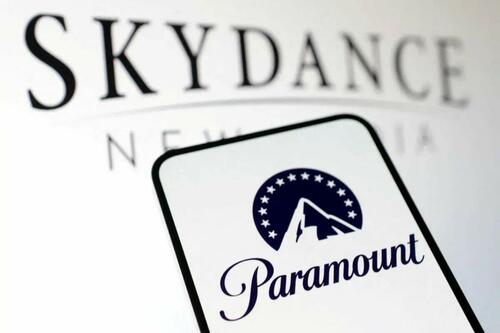67% Of Canadians Say Cost Of Living In Their Region Is Worst They've Seen
Authored by Jennifer Cowan via The Epoch Times (emphasis ours),
Nearly seven in every 10 Canadians are identifying the cost of living in their area as a major issue, according to a newly released survey.
 A person pushes a shopping cart through the produce section of a grocery store in Toronto, on Nov. 22, 2022. Carlos Osorio/Reuters
A person pushes a shopping cart through the produce section of a grocery store in Toronto, on Nov. 22, 2022. Carlos Osorio/Reuters
An Abacus Data poll found that 67 percent of the 1,500 people surveyed earlier this month said the cost of living in their area is the worst they can ever remember it being. Another 21 percent say the cost of living is bad where they live, although they can recall periods when it was even more challenging.
Only 11 percent say the cost of living is not bad, the survey said.
A recent poll in the United States found that 46 percent of Americans say the cost of living is the most challenging they can recall, which suggests that Canadians are experiencing this pressure even more intensely, Abacus Data CEO David Coletto said in the survey report.
Canadians polled also said the cost of living should be the federal government’s top priority. Sixty-two percent of people polled identified it as one of their top three issues compared to health care at 40 percent, and economic growth at 34 percent.
Housing affordability was fourth on the list at 25 percent, followed by immigration and the Canada-U.S. trade relationship at 24 percent.
Food and Housing Prices Top ConcernsThe cost of groceries play a major role in the cost of living and Canadians largely cited food prices as a contributing factor to the rising cost of living, Coletto said.
“The most widely cited concern is grocery prices, selected by 81 percent of Canadians,” he wrote. “Food prices are the most universal and emotionally resonant cost because they are unavoidable and visible every week.”
He noted that the concern rises sharply with age, from 61 percent of those in the 18 to 29 age group to 93 percent of those who are 60 and older.
The survey results were released the same day as new data from Statistics Canada indicated an increase in food prices in November, following a similar rise in October.
Food prices from stores experienced a year-over-year increase of 4.7 percent in November following a rise of 3.4 percent the previous month, StatCan said.
Housing expenses, such as rent, mortgage payments, and property prices, was the second most-frequently cited cost-of-living issue, accounting for 50 percent overall.
“Here the generational divide is clearer,” Coletto said. “Six in 10 Canadians under 30 cite housing as a major pressure, compared with fewer than four in 10 among those aged 60 and over.”
While other costs were mentioned as a concern by those surveyed, they held less significance than food or housing costs. Still, utility bills, household item prices, health-care costs, transportation costs, insurance bills, and debt repayments are all on Canadians’ radar, the poll found.
“While affordability is a shared concern, what people mean by affordability varies by life stage,” Coletto said. “Messages that treat the cost of living as a single problem risk missing the specific pressure points that different audiences feel most acutely.”
Political ImpactThe increasing cost of living has been identified as the primary concern nationwide; however, this issue is especially pronounced in Atlantic Canada and Ontario, according to the poll’s findings.
A significant majority across all age demographics said affordability should be a primary focus for the federal government, Coletto said. Younger Canadians tend to associate this issue with housing affordability, whereas older Canadians are more inclined to connect it with health care and Canada’s trade relationship with the United States.
Many Canadians see affordability as a structural and global issue rather than merely the consequence of a single government’s choices, which mitigates blame, despite ongoing high levels of frustration, Coletto said. But he warned that could change over time.
“For now, the cost of living remains a warning light rather than a red light for the Carney government,” he wrote. “But the intensity of feeling, combined with seasonal pressures and fragile household finances, means the issue is unlikely to fade quietly into the background.”
Tyler Durden Wed, 12/17/2025 - 20:05
 The U.S. Navy warship USS Lake Erie docks at the Port of Balboa in Panama City on Aug. 29, 2025. The United States sent three warships to the region amid escalating tensions with Venezuela. Mauricio Valenzuela/AFP via Getty Images
The U.S. Navy warship USS Lake Erie docks at the Port of Balboa in Panama City on Aug. 29, 2025. The United States sent three warships to the region amid escalating tensions with Venezuela. Mauricio Valenzuela/AFP via Getty Images








 Within a day of each other, two midair disasters nearly unfolded off Venezuela involving USAF refueling tankers, like this KC-45 Pegasus (USAF Photo)
Within a day of each other, two midair disasters nearly unfolded off Venezuela involving USAF refueling tankers, like this KC-45 Pegasus (USAF Photo) As it climbed out of Aruba, a Dassault 900EX like this one was almost destroyed by a KC-46 tanker operating off Venezuela
As it climbed out of Aruba, a Dassault 900EX like this one was almost destroyed by a KC-46 tanker operating off Venezuela



 Teslas fill the charging stations at a newly opened Tesla Diner in Hollywood, Calif., July 22, 2025. Jill McLaughlin/The Epoch Times
Teslas fill the charging stations at a newly opened Tesla Diner in Hollywood, Calif., July 22, 2025. Jill McLaughlin/The Epoch Times

 via AP
via AP
 Netflix and Warner Bros Discovery logos are seen in this illustration created on Dec. 5, 2025. Dado Ruvic/Reuters
Netflix and Warner Bros Discovery logos are seen in this illustration created on Dec. 5, 2025. Dado Ruvic/Reuters Paramount Global and Skydance logos are seen in this illustration taken on Dec. 17, 2024. Dado Ruvic/Reuters
Paramount Global and Skydance logos are seen in this illustration taken on Dec. 17, 2024. Dado Ruvic/Reuters




Recent comments